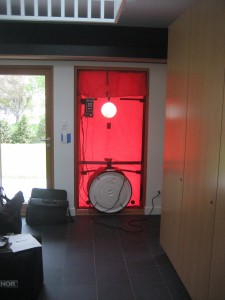 This credit is about sealing up the house. The tighter the home, particularly those in more extreme climates, the less energy it uses for heating and cooling; typically these houses are also more comfortable because they are draft-free. The tradeoff, though, is that a very well-sealed home can lead to poor indoor air quality and mold growth. As our number one goal was to create a healthy home, that meant that we needed to pay a lot of attention to the mechanical forced-air system. While this credit rewards homes that use air sealing techniques to tighten the envelopes of new homes, another credit under Indoor Environmental Quality (EQ 4) addresses the balance between mechanical and natural air ventilation. This credit also requires that air leakage be tested and verified by an energy rater (commonly referred to as a blower door test).
This credit is about sealing up the house. The tighter the home, particularly those in more extreme climates, the less energy it uses for heating and cooling; typically these houses are also more comfortable because they are draft-free. The tradeoff, though, is that a very well-sealed home can lead to poor indoor air quality and mold growth. As our number one goal was to create a healthy home, that meant that we needed to pay a lot of attention to the mechanical forced-air system. While this credit rewards homes that use air sealing techniques to tighten the envelopes of new homes, another credit under Indoor Environmental Quality (EQ 4) addresses the balance between mechanical and natural air ventilation. This credit also requires that air leakage be tested and verified by an energy rater (commonly referred to as a blower door test).
The performance requirements depend on the IECC Climate Zone you are in; since we live in Minneapolis, we are in climate zone 6. The measurement standard is referred to as “air changes per hour” (ACH) at the standard pressure differential, indoor to outdoor, of 50 pascals (equivalent to about a 20-mile-per-hour wind buffeting the home). The prerequisite in our climate zone is 5.0 ACH50; we get 2 points at 3.5 ACH50 and 3 points at 2.0 ACH50 — so lower is better.
How would we know? We had a blower door test performed, as shown in the photo. Our rater did not give us the straight ACH50 number, but he did get an Infiltration Rate of 1109. The LEED Reference Manual provides a calculation to normalize the leakage based on on the surface area of all sides of the building enclosure. Using that metric, we are in the mid-level, giving us 2 points for this credit. I am a little surprised we are not at the 3-point level, but given the number of windows and doors, that’s probably how it goes. In relative terms, though, our house is tight! And it is comfortable, too.
EA Prescriptive Path points so far: 4
